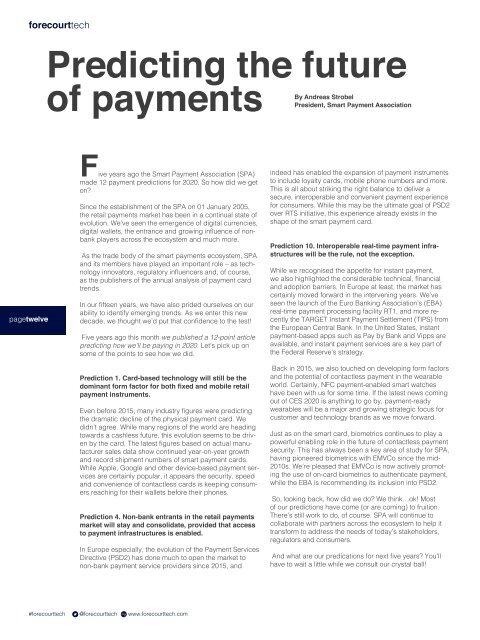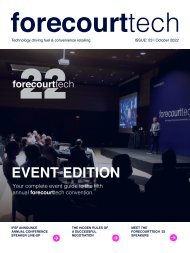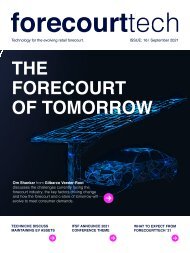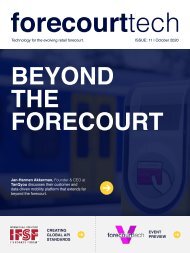forecourttech February 20
A bi-monthly technology magazine for the evolving retail forecourt.
A bi-monthly technology magazine for the evolving retail forecourt.
Create successful ePaper yourself
Turn your PDF publications into a flip-book with our unique Google optimized e-Paper software.
<strong>forecourttech</strong><br />
Predicting the future<br />
of payments<br />
By Andreas Strobel<br />
President, Smart Payment Association<br />
pagetwelve<br />
Five years ago the Smart Payment Association (SPA)<br />
made 12 payment predictions for <strong>20</strong><strong>20</strong>. So how did we get<br />
on?<br />
Since the establishment of the SPA on 01 January <strong>20</strong>05,<br />
the retail payments market has been in a continual state of<br />
evolution. We’ve seen the emergence of digital currencies,<br />
digital wallets, the entrance and growing influence of nonbank<br />
players across the ecosystem and much more.<br />
As the trade body of the smart payments ecosystem, SPA<br />
and its members have played an important role – as technology<br />
innovators, regulatory influencers and, of course,<br />
as the publishers of the annual analysis of payment card<br />
trends.<br />
In our fifteen years, we have also prided ourselves on our<br />
ability to identify emerging trends. As we enter this new<br />
decade, we thought we’d put that confidence to the test!<br />
Five years ago this month we published a 12-point article<br />
predicting how we’ll be paying in <strong>20</strong><strong>20</strong>. Let’s pick up on<br />
some of the points to see how we did.<br />
Prediction 1. Card-based technology will still be the<br />
dominant form factor for both fixed and mobile retail<br />
payment instruments.<br />
Even before <strong>20</strong>15, many industry figures were predicting<br />
the dramatic decline of the physical payment card. We<br />
didn’t agree. While many regions of the world are heading<br />
towards a cashless future, this evolution seems to be driven<br />
by the card. The latest figures based on actual manufacturer<br />
sales data show continued year-on-year growth<br />
and record shipment numbers of smart payment cards.<br />
While Apple, Google and other device-based payment services<br />
are certainly popular, it appears the security, speed<br />
and convenience of contactless cards is keeping consumers<br />
reaching for their wallets before their phones.<br />
Prediction 4. Non-bank entrants in the retail payments<br />
market will stay and consolidate, provided that access<br />
to payment infrastructures is enabled.<br />
In Europe especially, the evolution of the Payment Services<br />
Directive (PSD2) has done much to open the market to<br />
non-bank payment service providers since <strong>20</strong>15, and<br />
indeed has enabled the expansion of payment instruments<br />
to include loyalty cards, mobile phone numbers and more.<br />
This is all about striking the right balance to deliver a<br />
secure, interoperable and convenient payment experience<br />
for consumers. While this may be the ultimate goal of PSD2<br />
over RTS initiative, this experience already exists in the<br />
shape of the smart payment card.<br />
Prediction 10. Interoperable real-time payment infrastructures<br />
will be the rule, not the exception.<br />
While we recognised the appetite for instant payment,<br />
we also highlighted the considerable technical, financial<br />
and adoption barriers. In Europe at least, the market has<br />
certainly moved forward in the intervening years. We’ve<br />
seen the launch of the Euro Banking Association’s (EBA)<br />
real-time payment processing facility RT1, and more recently<br />
the TARGET Instant Payment Settlement (TIPS) from<br />
the European Central Bank. In the United States, instant<br />
payment-based apps such as Pay by Bank and Vipps are<br />
available, and instant payment services are a key part of<br />
the Federal Reserve’s strategy.<br />
Back in <strong>20</strong>15, we also touched on developing form factors<br />
and the potential of contactless payment in the wearable<br />
world. Certainly, NFC payment-enabled smart watches<br />
have been with us for some time. If the latest news coming<br />
out of CES <strong>20</strong><strong>20</strong> is anything to go by, payment-ready<br />
wearables will be a major and growing strategic focus for<br />
customer and technology brands as we move forward.<br />
Just as on the smart card, biometrics continues to play a<br />
powerful enabling role in the future of contactless payment<br />
security. This has always been a key area of study for SPA,<br />
having pioneered biometrics with EMVCo since the mid-<br />
<strong>20</strong>10s. We’re pleased that EMVCo is now actively promoting<br />
the use of on-card biometrics to authenticate payment,<br />
while the EBA is recommending its inclusion into PSD2.<br />
So, looking back, how did we do? We think…ok! Most<br />
of our predictions have come (or are coming) to fruition.<br />
There’s still work to do, of course. SPA will continue to<br />
collaborate with partners across the ecosystem to help it<br />
transform to address the needs of today’s stakeholders,<br />
regulators and consumers.<br />
And what are our predications for next five years? You’ll<br />
have to wait a little while we consult our crystal ball!<br />
#<strong>forecourttech</strong> @<strong>forecourttech</strong> www.<strong>forecourttech</strong>.com


















